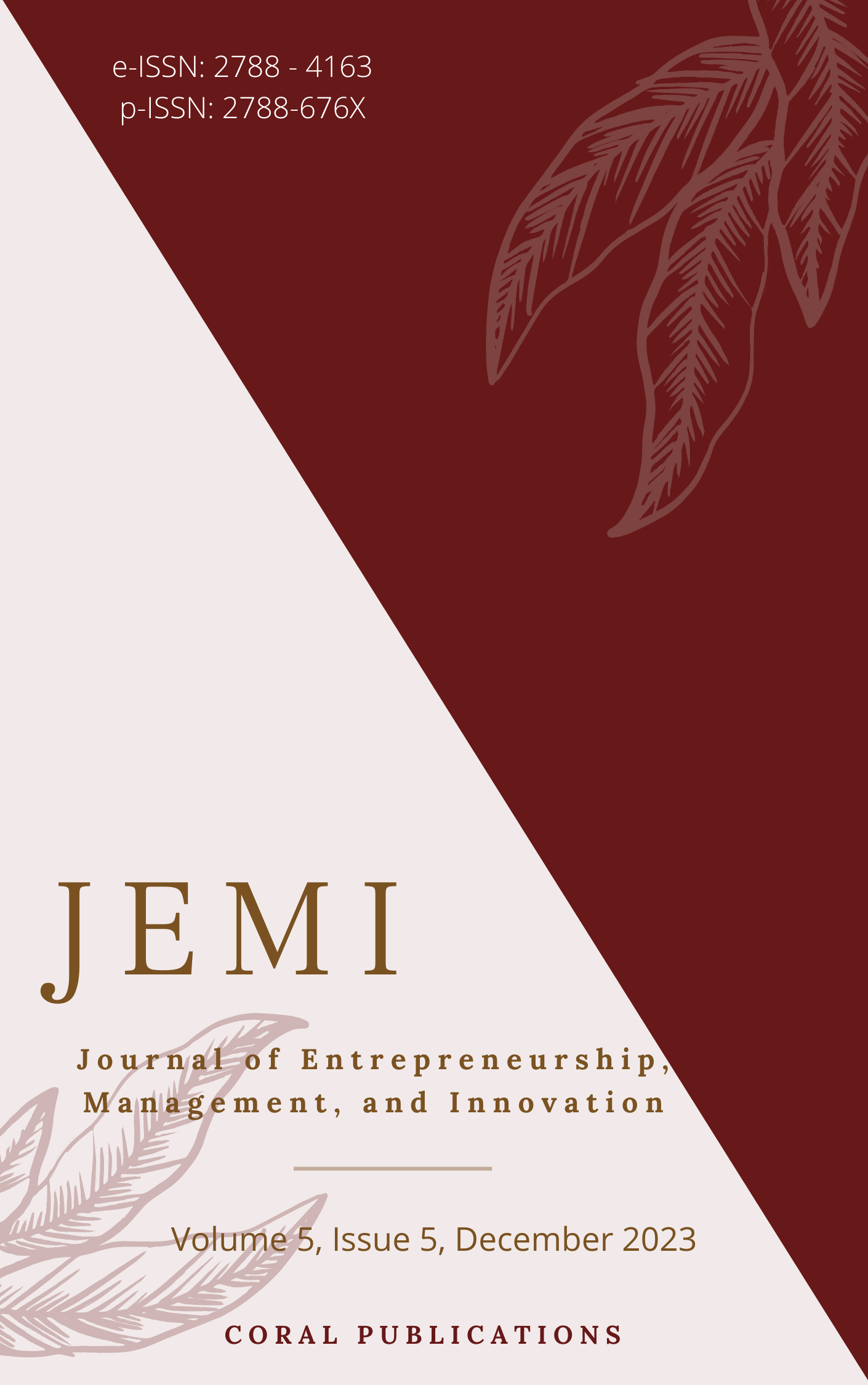Pakistan’s Trade Insight in Terms of Gravity Model: An Empirical Evidence
DOI:
https://doi.org/10.52633/jemi.v5i5.358Keywords:
International Trade, Gravity Model, Trade Agreements, Panel Data AnalysisAbstract
This study is intended to analyze the determinants of the trade potential of Pakistan. For the said purpose, the study employed an augmented gravity model over the data of 12 trading partner countries of Pakistan for the period of 20 years from 2002 to 2022. The dependent variable is merchandise trade, while the independent variables consist of core variables i.e., GDP & bilateral distance, and explanatory variables like population, common border, and preferential trade agreement. Breusch-Pegan and Hausman's tests were used for model selection, which proposes that the Random effect model is appropriate for estimation. The results confirm that distance among trading states hurts trade between them. Although the GDP of Pakistan shows a positive effect on trade the relation is inconsequential. However, the impact of GDP on trading associates of Pakistan is positive and highly substantial. The population of trading allies of Pakistan is showing a significant positive impact on trade. Common border and preferential trade agreements between the trading partners have a significant negative influence on trade. The study concludes that for Pakistan, the larger the distance with its trading associate country the smaller the trade among them and Pakistan has greater trading potential with larger economies as compared to smaller ones.
References
Abbas, S., & Waheed, A. (2015). Pakistan's potential export flow: The gravity model approach. The Journal of Developing Areas, 49(4), 367-378
Aliyu, S. U., & Bawa, S. (2015). Gravity model by panel data approach: empirical evidence from Nigeria. International Journal of Trade and Global Markets, 8(1), 42-57. https://mpra.ub.uni-muenchen.de/52549/.
Alleyne, A., & Lorde, T. (2014). A gravity model approach to analyzing the trade performance of Caricom member states. Applied Econometrics and International Development, 14(2), 145-160.
Almog, A., Bird, R., & Garlaschelli, D. (2019). Enhanced gravity model of trade: reconciling macroeconomic and network models. Frontiers in Physics, 7, 55. Doi: 10.3389/fphy.2019.00055
Anderson, J. E. (2010). The Gravity Model, National Bureau of Economic Research (No. 16576). Working paper. http://www.nber.org/papers/w16576
Anderson, J. E., & Van Wincoop, E. (2003). Gravity with gravitas: A solution to the border puzzle. American Economic Review, 93(1), 170-192.
Capoani, L. (2023). Review of the gravity model: origins and critical analysis of its theoretical development. SN Business & Economics, 3(5), 95. https://doi.org/10.1007/s43546-023-00461-0.
Chaney, T. (2018). The gravity equation in international trade: An explanation. Journal of Political Economy, 126(1), 150-177.
Demidova, S., Naito, T., & Rodríguez-Clare, A. (2022). The Small Open Economy in a Generalized Gravity Model (No. w30394). National Bureau of Economic Research. http://www.nber.org/papers/w30394.
Ekanayake, E. M., Mukherjee, A., & Veeramacheneni, B. (2010). Trade blocks and the gravity model: A study of economic integration among Asian developing countries. Journal of Economic Integration, 627-643.
Gonzalez Esteban, A. L. (2021). The determinants of world wheat trade, 1963-2010: A gravity equation approach.
Hassan Khayat, S. (2019). A gravity model analysis for trade between the GCC and developed countries. Cogent Economics & Finance, 7(1), 1703440. https://doi.org/10.1080/23322039.2019.1703440.
Irshad, M. S., Xin, Q., Shahriar, S., & Ali, F. (2018). South Korea’s potential export flow: A panel gravity approach. Asian Journal of Empirical Research, 8(4), 124-139.
Ismaiel Ali Ismaiel, M., Zhou, D., Shawky Eladawy, R., El-Rasoul, A. A. E. Y. A., Tawfik Yousef Alkhateeb, T., Ali Ahmed Abdullah, T., & Mahmood, H. (2023). Determinants and potential of trade using the gravity model approach: Empirical evidence of Egyptian Rice Crop. Complexity, 2023, 1-16. https://doi.org/10.1155/2023/4791707.
Jayasooriya, S. P. (2021). Bayesian gravity model for digitalization on bilateral trade integration in Asia (No. 1232). ADBI Working Paper Series. https://www.adb.org/publications/bayesian-gravity-model-digitalization.
Leitão, N. C. (2023). A Gravity Model Analysis of Portuguese Foreign Direct Investment. Economies, 11(9), 237. https://doi.org/10.3390/ economies11090237
Linnemann, H. (1966). An econometric study of international trade flows (No. 42). North-Holland Pub. Co.
Metin, I., & Tepe, G. (2021). Gravity model: A bibliometric analysis and detailed overview. International Journal of Business and Society, 22(1), 365-381.
Ming, L. S., & Adam, R. (2016). Gravity model on a single commodity: a review of the literature. Management Research Journal, 5, 32-39.
Olanike Kareem, F., & Kareem, I. O. (2014). Specification and estimation of gravity models: A review of the issues in the literature. Robert Schuman Centre for Advanced Studies Research Paper No. RSCAS, 74.
Pal, I., & Kar, S. (2021). Gravity Models in International Trade: An Exploration in Econo-Physics. South Asian Journal of Macroeconomics and Public Finance, 10(1), 72-104.
Pöyhönen, P. (1963). A tentative model for the volume of trade between countries. Weltwirtschaftliches archiv, 93-100.
Sinaga, A. M., Masyhuri, Darwanto, D. H., & Widodo, S. (2019, June). Employing the gravity model to measure international trade potential. In IOP Conference Series: Materials Science and Engineering (Vol. 546, No. 5, p. 052072). IOP Publishing.
Stay, K., & Kulkarni, K. G. (2016). The Gravity Model of International Trade, a Case Study: The United Kingdom and Her Trading Partners. Amity Global Business Review, 11.
Sultan, M., & Munir, K. (2015). Export, import and total trade potential of Pakistan: A gravity model approach. MPRA Paper No. 66621. https://mpra.ub.uni-muenchen.de/66621/.
Tinbergen, J. (1962). Shaping the world economy; suggestions for an international economic policy. Books (Jan Tinbergen).
Viner, J. (2014). The customs union issue. Oxford University Press, USA.
Wlazel, M. (2014). Gravity model for Czech Republic-Test of the effects of indirect trade. Charles University in Prague, Faculty of Social Sciences, Institute of Economic Studies. 92.
Downloads
Published
Issue
Section
License
Copyright (c) 2023 Amber Hasan, Dr. Rummana Zaheer (Author)

This work is licensed under a Creative Commons Attribution 4.0 International License.











